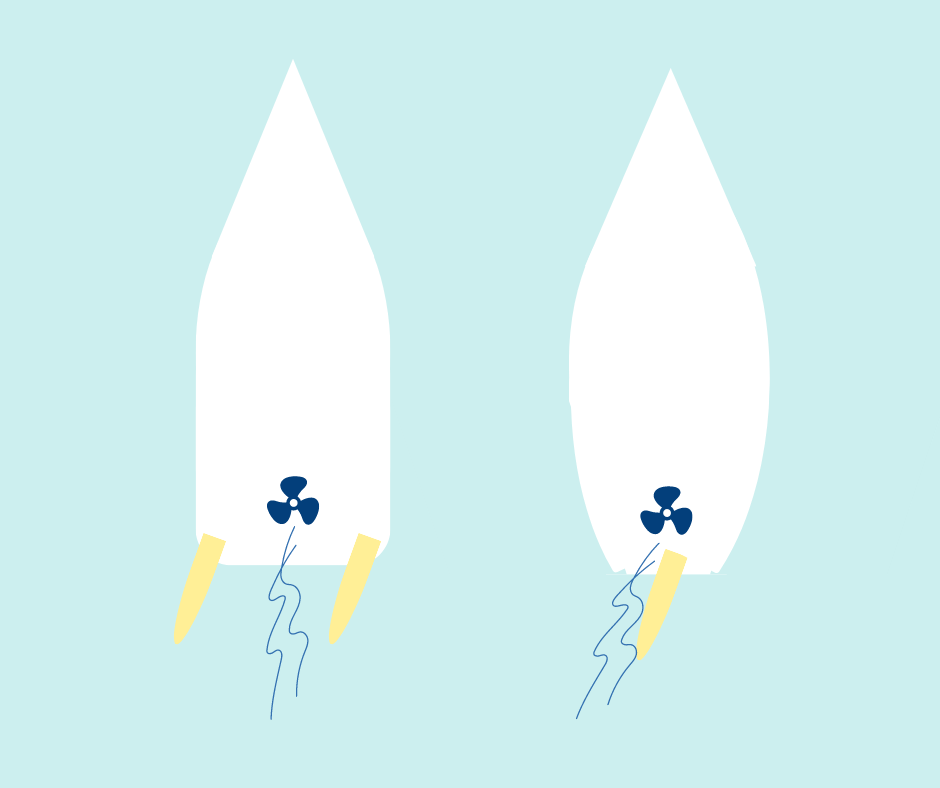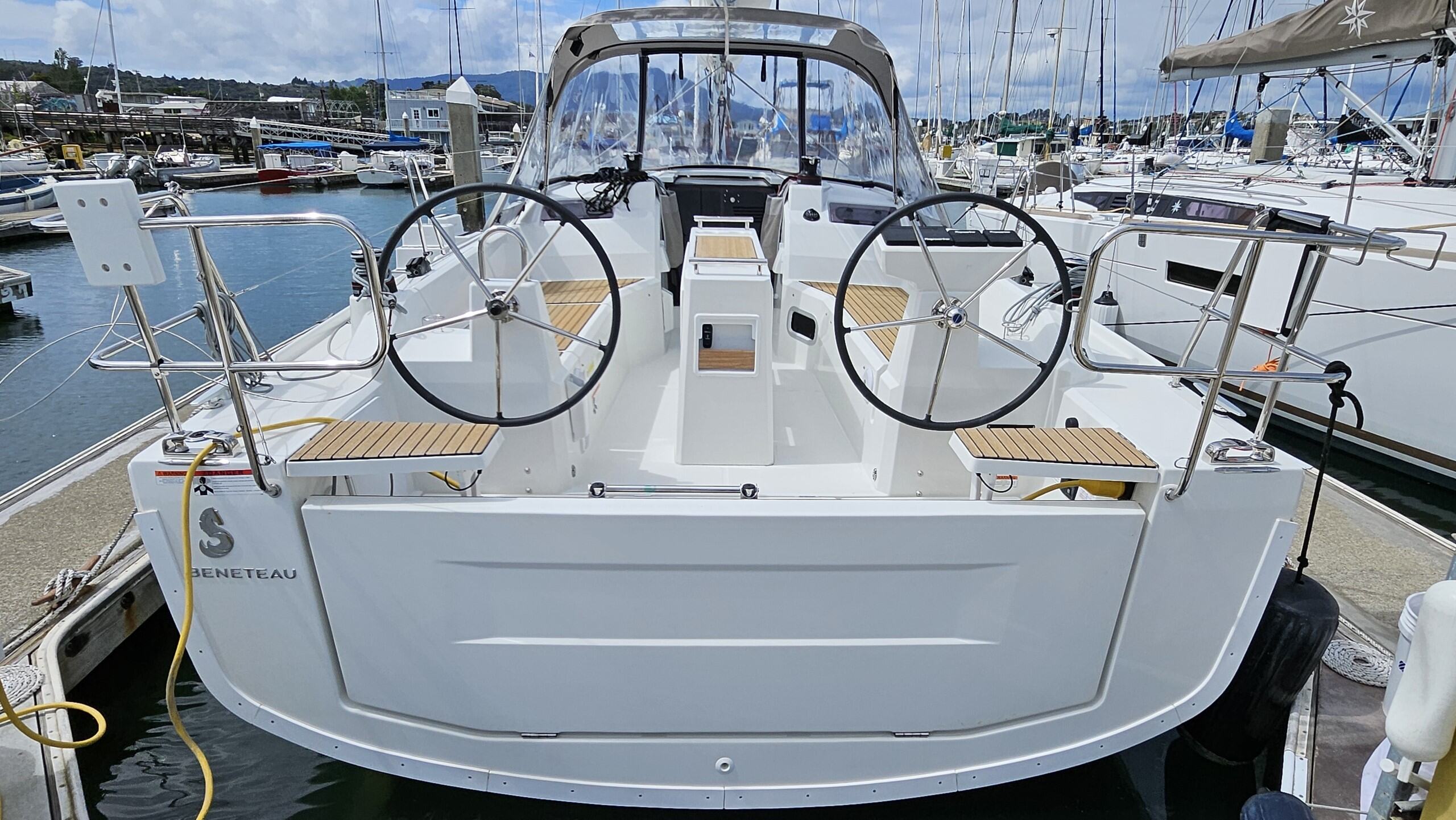
Dual rudders, also referred to as twin or double rudders, are becoming more common in modern sailboats, both cruising and performance yachts alike. Since dual rudder boats handle differently than single rudders when maneuvering under engine power, it’s important for our charterers to know which boats in our fleet have dual rudders and to understand differences in the way they handle in tight spaces like dock slips and narrow fairways.
First, let’s have a look at the advantageous reasons dual rudders are becoming popular in modern boat design, as well as the challenges they can present to the uninformed. We’ll then give you some tips to help you get prepared for successful maneuvering in and out of the marina.
Dual Rudder Advantages
- To make for roomier cockpits and more space below deck for accommodations and storage, design trends are leaning toward wider transoms. Dual rudders improve the handling of a boat with a wide transom especially when heeling under sail.
- Dual wheels offer a more open cockpit layout and enable better visibility for the driver on the helm, especially when flying a jib or other headsail.
- Dual rudders facilitate better tracking when the boat is heeling, as there is always one rudder in the water. This means better control and a reduced tendency to round up.
- The propeller lies forward and between the twin rudders rather than in line with a single rudder.
Dual Rudder Challenges
- Twin rudders depend on the momentum of the boat for steerage. In other words, when the boat is stopped, hydrostatic pressure on the rudders is not established until the boat starts moving through the water. There is no effect of “prop wash” (the flow of water over the rudder produced by the spinning propeller). This means you will need to apply more engine power and speed to gain steerage during dock departures and entries than you would with a single rudder boat. This lag in response takes some getting used to. It also means that an on-point “standing turn” isn’t possible since it cannot pivot tightly in reverse using "prop wash" alone. Avoid oversteering when maneuvering in tight areas. Plan approaches early and carry slight sternway when required.
- Bow thrusters can help compensate in difficult conditions, but before you attempt to use bow thrusters, focus on learning how to dock without them first, and be sure to read this article: Bow Thruster Basics
Boats with Dual Rudders in the Modern Sailing Fleet
Helix and Polaris (Beneteau Oceanis 30.1), Traharta (Beneteau Oceanis 35) Survivor (Beneteau Oceanis 38), Liberty (Beneteau Oceanis 38.1), Bora Bora (Premier Tier Beneteau Oceanis 34.1), and Firefly (Premier Tier Beneteau Oceanis 40.1) are equipped with twin rudders and helms. Survivor, Liberty, Bora Bora, and Firefly also have bow thrusters.
Tips for Docking a Dual Rudder Boat
Departing the Dock Slip
IMPORTANT: With a single rudder, when you apply a quick burst of throttle, prop wash (in forward gear) over the rudder allows you to steer the boat without needing to move forward. With dual rudders, you’ll need a longer burst to accelerate the boat and move forward for the boat to turn.
- If you need to turn your stern to starboard to head left out the fairway, then turn the wheel to starboard. This applies to Sausalito B and C Dock boats Helix, Traharta, Bora Bora, Survivor, and Liberty.
- If you need to turn your stern to port to head right out a fairway, turn the wheel to port. On A Dock boats Ry Whitt and Attitude Adjustment, back up straight, and once sufficiently clear from the dock, turn away from shore to avoid nearby shallow areas. (Rocks - ouch!)
- You’ll need to use your best judgement to determine how far to turn the wheel – it will depend on the wind and current.
Let's imagine you're backing Traharta out of her slip on B Dock. Put the engine in reverse gear and apply a bit more throttle than you normally would on a single rudder boat. Keep the boat as straight in the slip as possible as you begin to back up. When the boat is 3/4 of the way out of the slip, turn the wheel to starboard, shift the engine into neutral gear and allow the boat to glide backwards into your starboard turn. When clear of the dock, turn the wheel to port, put the engine in forward gear, and slowly increase throttle as you head out of the fairway.
While you're out on the water, we highly recommend you take some time to practice maneuvering a dual rudder sailboat in a safe area like an unoccupied mooring field. (Of course, always check the charts before entering an unfamiliar area to ensure adequate depth.) You can use mooring balls or buoys as points of reference as you get a feel for how the boat maneuvers. Be sure to give plenty of room for error around fixed objects. You’ll especially want to practice slowing the boat to get a feel for the speed at which it loses steerage. This will help you to better judge the minimum amount of speed you'll need to maintain control of the boat as you maneuver.
Entering the Dock Slip
Heading down the fairway and approaching the dock, once again, you’ll need a bit more momentum than you would in a single rudder boat. As you begin to turn toward the dock slip, don’t slow down too much or you could lose steerage and miss. Maintain momentum until you have completed the turn and the boat is aligned with the slip. When you enter the slip, at the last moment, reverse the engine and throttle up to stop the boat. Because you entered the slip with more momentum than you would on a single rudder boat, you’ll also need to apply more RPMs to stop the boat. Again, use your best judgement on how high to throttle up based on the conditions.
Want More Training?
Schedule a dockside briefing on the morning of your charter. Our friendly fleet and office teams will give you a quick tour of the specific vessel you reserved. This is not a lesson on how to maneuver a dual rudder boat. Here's some of the ways you can get docking practice and training with one of our experienced instructors:
- ASA 118, Docking Endorsement Clinic
- Platinum Fleet Docking & Maneuvering Clinic
- Development Sails
- Private Lessons
Need Help at the Dock?
Whenever you find yourself approaching a docking situation that feels uncomfortable for you (such as in a strong wind), it's always okay to ask for help. Call the Modern Sailing team on VHF radio channel 71 if you would like some help with dock entry. Please be aware that only our licensed and certified instructors are qualified to provide docking instruction, but a fleet team member standing on the dock can help you cast off or catch your lines as you depart or come in. We're happy to help!
Did you find this article helpful? See our Member Resources library for more like it.




